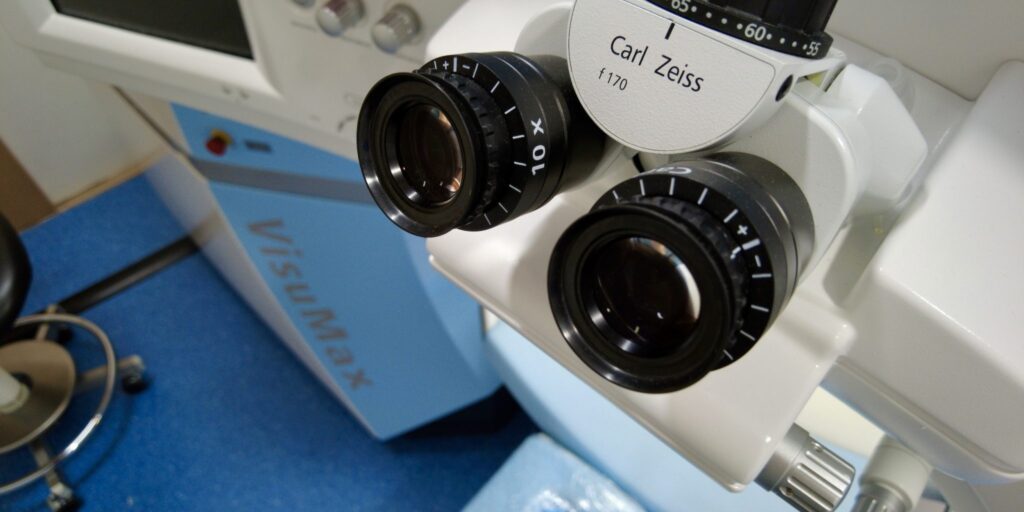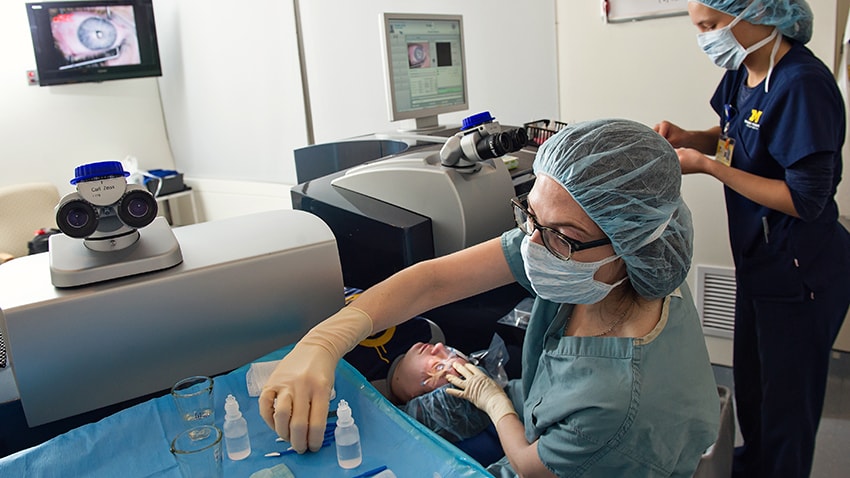PRK and LASIK are laser eye surgeries used to correct eyesight. Meanwhile, PRK has existed longer than LASIK, but both are widely performed today.
LASIK and PRK procedures are both used to correct the eye’s cornea. The cornea comprises five thin layers of tissue in the eye that bend and focus light to help you see more clearly.PRK and eye surgery lasik procedures use different techniques to correct vision by reshaping the corneal tissue.
With the PRK procedure, the eye doctor removes the epithelium. He then uses eye surgery lasik to reshape the other layers of the cornea and fix weird twists in your eye.
These lasers surgeries create a small flap in the cornea. The surgeon raises the flap with a laser and then uses lasers to reshape the cornea. When that is done, the corneal flap lowers back down after the procedure is complete, and the cornea repairs itself within the next few weeks or months.

Either technique can resolve eye issues such as:
- Nearsightedness or myopia: inability to focus on distant objects
- Farsightedness or hyperopia: inability to see near things
- astigmatism: is an irregular structure that causes a blurry vision
How do these procedures work?
The two laser procedures have a similar process: they reshape irregular cornea tissues with lasers. But they vary in some ways:
- In the PRK procedure, surgeons remove a part of the cornea tissue.
- During the eye surgery lasik procedure, surgeons create a flap to open the tissues and close the flap when the procedure finishes.
What happens during the PRK procedure?
- You receive numbing drops, so don’t feel any pain during the procedure. You can also receive drugs to relax your nerves.
- The epithelium is removed. That takes about 30 seconds.
- The surgeon uses an excimer laser to fix any wrongs in the corneal tissue layers. That also takes up to 30-60 seconds.
- A bandage is put on your cornea to heal the tissues underneath the cornea.
What happens during a LASIK procedure?
- You are given medications to numb your eye.
- THe surgeon cuts a small corneal flap into the epithelium with a femtosecond laser. That lets him move the layer to the side and have enough space to reshape the other layers with the laser. Because it’s attached, it is easier for the surgeon to fix the epithelium to its proper place after the procedure finishes rather than removing it entirely as it is in PRK.
- An excimer laser helps reshape your corneal tissues and fix eye curvature issues.
- The surgeon restores your corneal flap in the epithelium to heal with the rest of the tissues.

How long is recovery?
You can feel a little discomfort during each procedure. You can also notice quick changes in your vision as the surgeon reshapes your eye tissue. But the entire process is painless.
Complete recovery will take three weeks to a month with the PRK procedure. Recovery from eye surgery lasik is faster and takes a few days to have a sharper vision.
PRK recovery
Following the PRK procedure, you will have a bandage over your eyes which sometimes can cause sensitivity to direct light or irritation for some days as your epithelium recovers. Your vision can continue to blurry until you remove the contact-like bandage after a few weeks.
Your surgeon can prescribe certain medicated eye drops to keep your eye moist for quick recovery. You can also use medications according to the prescription of your surgeon to relieve your pain.
You can start to experience bright vision immediately after the surgery. However, it may worsen later if you are not adhering to the precautions. Your ophthalmologist would instruct you to avoid strenuous activities like driving until your vision become perfect.
The full recovery process may last for a month. Your vision then gets better day after day. You will have to visit your healthcare provider regularly for re-examination and reports until your perfect vision is fully restored.
LASIK recovery
You might see more right after the eye surgery lasik procedure than before when using eyeglasses or contact lenses. From experience, you will be close to your desired vision after the first 24 hours.
You will experience less pain as your eye recovers. In most instances, you might feel a slight burning sensation in your eyes for a few hours after the eye surgery lasik procedure. Still, it should relieve you after some hours. Your doctor will then apply medicated eye drops to prevent irritation.
Your vision should become perfect within some days after the procedure. Click here for tips to aid quick recovery after a lasik procedure.

Which one is more effective?
Both LASIK and PRK procedures are effective in correcting vision. They only differ in how long it takes to heal.
LASIK procedure takes some days to see, while PRK can take up to a month. Meanwhile, the results won’t differ if the surgeon did an excellent job procedure.
Overall, the PRK procedure is safer in the long term. That is because it doesn’t leave a flap in your cornea. A surgeon leaves a flap behind during the eye surgery lasik procedure, which can cause severe complications.
What are the risks involved in both?
Both procedures come with a few risks. LASIK might be riskier because it requires the surgeon to create a flap in the patient’s cornea.
The potential risks associated with both procedures include:
- Eye dryness. eye surgery lasik procedure can produce some tears for about six months after the surgery, and that dryness can be permanent.
- Visual changes or disturbances. That may include reflections off objects and seeing halos around lights. When it aggravates, you might have a bad sight at night. it usually disappears after some weeks, but it can become permanent in rare cases.
- Under-correction. Your vision might not seem clearer if your surgeon didn’t remove enough corneal tissue, primarily if the surgery aims to correct nearsightedness.
- Visual distortion. Your surgeon may remove too much tissue than necessary during the procedure, which may cause ectasia. That complication can make the cornea too weak, bulging the eye from pressure. Your surgeon needs to resolve this issue on time to prevent possible vision loss.
- Astigmatism. This happens when your eye curvature changes. Sometimes, the surgeon forgets to remove the corneal tissue, which turns out bad. You may need to start wearing eyeglasses or contacts to correct this problem or do a follow-up surgery.
- LASIK flap complications. When there are issues with the corneal flap during the eye surgery lasik procedure, it can produce too many tears or lead to infection.
Conclusion
Both laser procedures cost up to $2,500 to $5,000. Although, PRK can be more expensive because it requires more follow-up check-ins. Health insurance plans cover LASIK and PRK procedures because they are considered electives.
If you have health savings accounts, you can use them to cover the cost. Note that these plans are peculiar to only employer-sponsored health packages.
